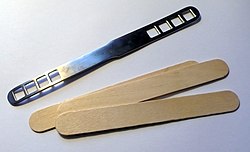Tongue depressor

A tongue depressor or spatula is a tool used in medical practice to depress the tongue to allow for examination of the mouth and throat. Hobbyists, artists, teachers and confectionery makers use tongue depressors, which may also be referred to as craft sticks or popsicle sticks.
Description
A tongue depressor is a tool used in medical practice to depress the tongue to allow for examination of the mouth and throat. For this use, it is also known as a spatula.[1]
History
Earlier versions of depressors were made from balsa, pine, or redwood woods. Tongue depressors made from wood and metal exist from the American Civil War.[2]
The most common modern tongue depressors are flat, thin, wooden blades, smoothed and rounded at both ends,[3] but, historically, tongue depressors have been made of a variety of materials.[4] Since they are inexpensive and difficult to clean because of their porous texture, wooden tongue depressors are labeled for disposal after a single usage.[5]
Other uses
Ice pops and ice cream bars have used wooden tongue depressors to hold the confection, leading to the name popsicle sticks. Hobbyists, artists and teachers use wooden tongue depressors in sculptural projects, which has led to the name craft sticks. [6][7]
References
- ^ "Spatula", Collins Dictionary of Medicine, Robert M. Youngson 2004, 2005
- ^ "Civil War Concenus, N.Y. hospital inventory list inventory". November 19, 2009. Archived from the original on November 19, 2009. Retrieved April 7, 2023.
- ^ "Definition of TONGUE DEPRESSOR". www.merriam-webster.com.
- ^ Cohen, J Solis. Diseases of the Throat and Nasal Passages: A Guide to the Diagnosis and Treatment of Affections of the Pharynx, Oesophagus, Trachea, Larynx, and Nares. Chapter II, Examination of the Throat and Nasal Passages. Published by W. Wood, 1884, 742 pp.
- ^ Landro, Laura. "Hospitals Reuse Medical Devices To Lower Costs". WSJ.
- ^ Kent Wood, Ric LaBan. N Scale Model Railroad That Grows Kalmbach Publishing, Co., 1996.
- ^ LaBritta Gilbert, Linda Greigg. Do touch: instant, easy hands-on learning experiences for young children Published by Gryphon House, Inc., 1989.
External links
 Media related to Tongue depressor at Wikimedia Commons
Media related to Tongue depressor at Wikimedia Commons
Notes
This article is a direct transclusion of article and therefore may not meet the same editing standards as LIMSwiki.









